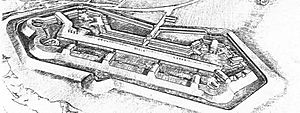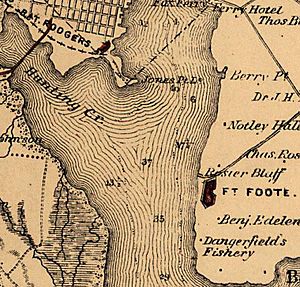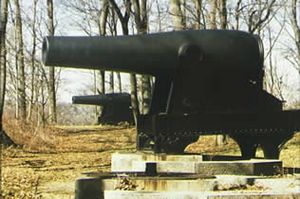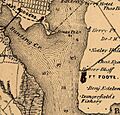Fort Foote facts for kids
Quick facts for kids Fort Foote |
|
|---|---|
| Prince George's County, Maryland | |

This drawing of Fort Foote shows a view of the fort looking to the east from above the Potomac River. Much of the interior buildings can be distinguished, as can the two sites of the Rodman guns mounted at the fort.
|
|
| Coordinates | 38°46′00″N 77°01′40″W / 38.7666667°N 77.0277778°W |
| Type | Earthwork fort |
| Site information | |
| Owner | National Park Service |
| Open to the public |
Yes |
| Condition | Partially preserved, multiple guns at site |
| Site history | |
| Built | 1863 |
| Built by | U.S. Army Corps of Engineers |
| In use | 1863–1878 |
| Materials | Earth, timber |
| Battles/wars | American Civil War |
| Garrison information | |
| Garrison | 9th New York Heavy Artillery, others |
| Fort Foote Park | |
|---|---|
| Location | Prince George's County, Maryland, U.S. |
| Governing body | National Park Service |
Fort Foote was a strong fort built during the American Civil War. It was made of wood and earth. Its main job was to protect Washington, D.C. from attacks coming up the Potomac River. The fort was active from 1863 to 1878. It was also used for short times during World War I and World War II. Today, what's left of the fort is part of Fort Foote Park. This park is looked after by the U.S. National Park Service. It is part of the National Capital Parks-East system. The fort is near Fort Washington, Maryland.
Contents
Planning the Fort
When the American Civil War began, Washington, D.C. needed strong defenses. Most forts were built to stop attacks by land. In 1861, the Arlington Line of forts was built. This line protected the city from attacks coming from Virginia. More forts were built north of the city to guard against attacks from Maryland.
However, the city was still open to attacks from the water. Only Fort Washington, an older fort, guarded the Potomac River. It was built during the War of 1812.
Why a New Fort Was Needed
In 1862, two special ships, the USS Monitor and the CSS Virginia, fought a battle. These ships were "ironclads," meaning they were covered in thick iron. This battle showed how vulnerable Washington was. People worried that an ironclad ship could sneak past Fort Washington. Such a ship could then bomb the city.
There was also a fear that European countries might help the Confederacy. This could bring powerful navies to attack the city. So, a group of experts looked at Washington's defenses. They told Secretary of War Edwin M. Stanton that the city needed better river defenses.
They wrote that Washington's defense was not complete without protecting the river. They suggested building a new fort with ten guns. This fort would be on the opposite side of the Potomac River. They found a very good spot near Rosiers Bluff in Maryland.
Choosing the Location
John G. Barnard, a chief military engineer, quickly started working on the new fort. Rosiers Bluff was a perfect spot. It was a 100-foot (30-meter) high cliff in Maryland. It was about six miles (10 km) south of Washington.
The fort's design would follow ideas from a book by Dennis Mahan. He was an instructor at West Point. He wrote that a fort should be so strong that enemies would not try to storm it. It should force them to use slower, more planned attacks. The fort's ditches should be protected, and its walls very high. This would stop enemies from trying to climb over.
Building Fort Foote
Construction of Fort Foote began in the winter of 1862–1863. It was a slow start. It was hard to find enough workers at first. But in August 1863, four companies of soldiers arrived. They helped speed up the work. By fall, the fort was mostly finished and ready for use.
Because the fort was by the river, not much iron was used. Most of it was built from earth and local timber.
Fort Design and Materials
General Barnard later wrote about the fort's construction. He said that the walls and inner buildings were mostly made of cedar posts. The roofs of these buildings were made from chestnut logs. The part of the fort facing the Potomac River was over 500 feet (152 meters) long. Its earth walls were about 20 feet (6 meters) thick.
A central path, called a "traverse," ran through the fort. This path held bomb-proof magazines. These were safe places to store gunpowder and supplies. The fort held eight 200-pounder Parrott rifles. It also had two huge 15-inch Rodman guns.
Getting the Guns
The guns arrived slowly. There were delays in making them. Also, many guns were needed for battles in Virginia. The first 15-inch Rodman gun arrived in late 1863. Other guns came over the next two years. The fort was not fully armed until April 1865. This was just before the war ended.
Fort Foote was officially declared complete on June 6, 1865. By then, it had two 15-inch Rodman guns. It also had four 200-pounder Parrott rifles. Plus, it had eight 30-pounder Parrott rifles.
How the Fort Operated
In 1863, as the fort's walls grew taller, the first soldiers arrived. Four companies of the 9th New York Heavy Artillery Regiment came to Maryland. They immediately started working as laborers on the fort. Their commander was Lieutenant Colonel William H. Seward Jr.. He was the son of U.S. Secretary of State William H. Seward.
On August 20, 1863, several important people visited the new fort. These included Seward, President Abraham Lincoln, Secretary of War Edwin M. Stanton, and General Barnard. Secretary Seward visited Fort Foote often. This was because it was close to Washington and his son was stationed there.
One month after the President's visit, on September 17, 1863, the fort was named. Secretary Seward named it in honor of Admiral Andrew H. Foote. Admiral Foote was a naval commander during the war. He led a naval attack on Fort Donelson. He was badly wounded in that battle. He died later from his injuries. The fort was named to remember his bravery.

Daily Life at the Fort
Life at Fort Foote was much like other forts around Washington. A soldier's day started before sunrise with a bugle call called reveille. Then came morning muster. This is when soldiers were counted and reported if they were sick.
After muster, the day was filled with work. Soldiers improved the fort's defenses. They also practiced drills, like firing the guns or parade drills. This continued, with breaks for meals, until "taps" was played at night. Sundays were different. After muster, there was a weekly inspection and church. Sunday afternoons were free time. Soldiers would write letters, bathe, or catch up on sleep.
Fort Foote was close to Washington, but it felt isolated. The regular soldiers were far from the city's fun. The nearest road was over a mile away. It was only used when the Potomac River froze. Most communication with the fort was by a river dock. This dock was built in 1864. A mail boat stopped three times a week. Daily boats went to Alexandria and Washington. But these were only for officers and special visitors. Ordinary soldiers rarely got time off to visit Alexandria or Washington.
Living Conditions
Unlike many forts, soldiers at Fort Foote lived in wooden buildings outside the fort's walls. Even with this, duty at Fort Foote was not always pleasant. A large swamp was near Rosier's Bluff. Mosquitoes caused malaria during the summer. Also, it was hard to get clean water. This made typhoid a constant danger. In the summer, up to half the soldiers could be sick. The fort's hospital, a 10-by-40-foot building, would be full.
Special Events at the Fort
Fort Foote was close to Washington. It also had very large guns. So, many important people from Washington came to watch gunnery practice. On February 27, 1864, a big crowd watched the first firing of the fort's 15-inch guns. These huge cannons weighed 25 tons. They needed 45 pounds of gunpowder to fire a 440-pound cannonball over 5,000 yards (4,572 meters). These guns were much bigger than any land defense guns. They were meant to fight ironclad warships. Another festive firing happened on April 1, 1864.
Secretary Seward and his wife visited the fort often in the summer of 1864. They would watch demonstrations. They often brought important guests. Once, they came to watch target practice. The gunners were supposed to shoot at a target in the Potomac River. But Confederate supporters learned about it. They rowed out, cut the target loose, and took it away. The Union gunners had to fire at other targets. Mrs. Seward held an unplanned lunch in one of the fort's bunkers.
On October 22, 1864, the Sewards returned. They brought U.S. Secretary of the Treasury Salmon P. Chase, U.S. Secretary of the Navy Gideon Welles, and General Barnard. This visit was to celebrate the first firing of the fort's new 200-pounder Parrott rifles. By this time, the Civil War was ending. People in Washington began to wonder if the forts would be useful after the war. Secretary Welles said that the fort was strong but a lot of work was wasted. He believed no enemy fleet would ever come up the Potomac.
After the War
Secretary Welles's words came true. Fort Foote never fired its guns in a real battle. After the war ended in April 1865, the government returned most forts to their owners. But Fort Foote was one of the few they kept. It was used as a federal prison from 1868 to 1869.
Gun Testing
The fort was also used to test a new type of recoil gun carriage. In 1869, Major W. R. King set up a 15-inch gun. He started testing it. He fired 22 rounds from the gun. The amount of gunpowder used ranged from 25 to 100 pounds. The tests went well at first. But they had to stop. It was hard to find a safe area to fire. After the war, many commercial boats were on the Potomac. Firing 400-pound cannonballs over them was too dangerous. Also, the gun was too powerful for the narrow river. So, Major King moved his tests to New York in 1871.
Fort's Later Years
In 1872, plans were made to make the fort stronger. The government bought the land in 1873. They had been leasing it during the war. Work began on the improvements. But the money for the project was suddenly taken away. So, construction stopped. With fewer military funds after the war, the soldiers left in 1878. The fort was then abandoned.
Between 1902 and 1917, the fort was a training area for an engineering school. During this time, the old guns were removed. Only the two 15-inch cannons remained. One Parrott rifle was sent to a cemetery in Pennsylvania.
During World War I, the fort was used for gas training. In World War II, officer candidates from Fort Washington used the site. After that war, the fort was given to the Department of the Interior and the National Park Service. It became part of the national park system in the D.C. area.
Today, the area where the fort stood is mostly covered in trees. Some of the original fort walls are still there. Two 15-inch guns sit on their carriages, looking over the Potomac. Only one of these guns was originally at Fort Foote. The other came from Battery Rodgers, a fort on the other side of the river during the Civil War.
Images for kids
-
This map shows the location of Fort Foote on the east bank of the Potomac downstream from Battery Rodgers and Alexandria, Virginia.






